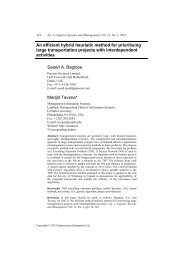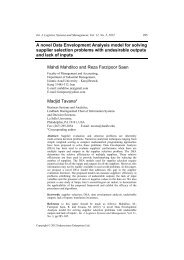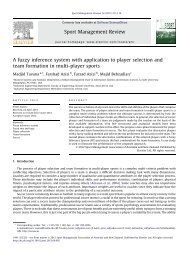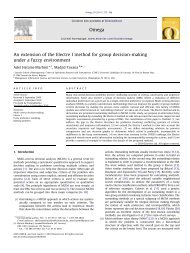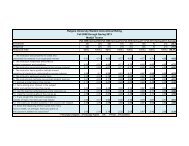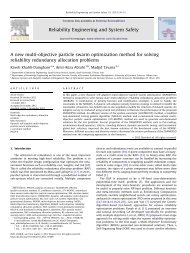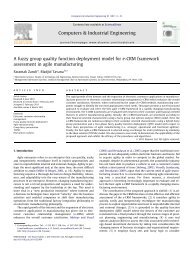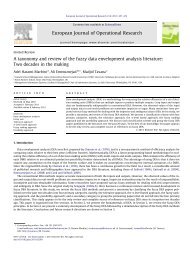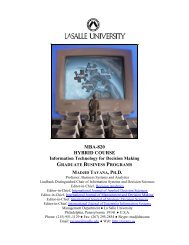A Fuzzy Multidimensional Multiple-Choice Knapsack - Dr. Madjid ...
A Fuzzy Multidimensional Multiple-Choice Knapsack - Dr. Madjid ...
A Fuzzy Multidimensional Multiple-Choice Knapsack - Dr. Madjid ...
You also want an ePaper? Increase the reach of your titles
YUMPU automatically turns print PDFs into web optimized ePapers that Google loves.
482 Ann Oper Res (2013) 206:449–483Farris, J. A., Groesbeck, R. L., Aken, E. M. V., & Letens, G. (2006). Evaluating the relative performanceof engineering design projects: a case study using data envelopment analysis. IEEE Transactions onEngineering Management, 53(3), 471–482.Florios, K., Mavrotas, G., & Diakoulaki, D. (2010). Solving multiobjective, multiconstraint knapsack problemsusing mathematical programming and evolutionary algorithms. European Journal of OperationalResearch, 203, 14–21.Ghapanchi, A. H., Tavana, M., Khakbaz, M. H., & Low, G. (2012). A methodology for selecting portfoliosof projects with interactions and under uncertainty. International Journal of Project Management.doi:10.1016/j.ijproman.2012.01.012.Ghasemi, T., & Razzazi, M. (2011). Development of core to solve the multidimensional multiple-choiceknapsack problem. Computers & Industrial Engineering, 60(2), 349–360.Guo, P., & Tanaka, H. (2001). <strong>Fuzzy</strong> DEA: a perceptual evaluation method. <strong>Fuzzy</strong> Sets and Systems, 119(1),149–160.Han, B., Leblet, J., & Simon, G. (2010). Hard multidimensional multiple choice knapsack problems, anempirical study. Computers & Operations Research, 37(1), 172–181.Hatami-Marbini, A., Saati, S., & Tavana, M. (2010). An ideal-seeking fuzzy data envelopment analysis framework.Applied Soft Computing, 10(4), 1062–1070.Hatami-Marbini, A., Emrouznejad, A., & Tavana, M. (2011). A taxonomy and review of the fuzzy dataenvelopment analysis literature: two decades in the making. European Journal of Operational Research,214, 457–472.Hwang, C. L., & Masud, A. S. M. (1979). <strong>Multiple</strong> objective decision making methods and applications.NewYork: Springer.Kao, C., & Liu, S. T. (2003). A mathematical programming approach to fuzzy efficiency ranking. InternationalJournal of Production Economics, 86(2), 145–154.Kellerer, H., Pferschy, U., & Pisinger, D. (2004). <strong>Knapsack</strong> problems. Berlin: Springer.Khalili-Damghani, K., & Sadi-Nezhad, S. (2013). A decision support system for fuzzy multi-objective multiperiodsustainable project selection. Computers & Industrial Engineering, 64, 1045–1060.Khalili-Damghani, K., Sadi-Nezhad, S., & Aryanezhad, M. B. (2011). A modular decision support systemfor optimum investment selection in presence of uncertainty: combination of fuzzy mathematical programmingand fuzzy rule based system. Expert Systems with Applications, 38, 824–834.Khalili-Damghani, K., Tavana, M., & Sadi-Nezhad, S. (2012). An integrated multi-objective framework forsolving multi-period project selection problems. Applied Mathematics and Computation, 219, 3122–3138.Khalili-Damghani, K., Abtahi, A.-R., & Tavana, M. (2013a). A new multi-objective particle swarm optimizationmethod for solving reliability redundancy allocation problems. Reliability Engineering & SystemsSafety, 111, 58–75.Khalili-Damghani, K., Sadi-Nezhad, S., Hosseinzadeh Lotfi, F., & Tavana, M. (2013b). A hybrid fuzzy rulebasedmulti-criteria framework for sustainable project portfolio selection. Information Sciences, 220,442–462.Khalili-Damghani, K., Tavana, M., & Nojavan, M. (2013c). Solving fuzzy multidimensional multiple-choiceknapsack problems: the multi-start partial bound enumeration method versus the efficient epsilonconstraintmethod. Applied Soft Computing, 13, 1627–1638.Lertworasirikul, S., Fang, S. C., Joines, J. A., & Nuttle, H. L. W. (2003). <strong>Fuzzy</strong> data envelopment analysis(DEA): a possibility approach. <strong>Fuzzy</strong> Sets and Systems, 139(2), 379–394.Lin, F. T. (2008). Solving the knapsack problem with imprecise weight coefficients using genetic algorithm.European Journal of Operational Research, 185(1), 133–145.Lin, F. T., & Yao, J. S. (2001). Using fuzzy numbers in knapsack problems. European Journal of OperationalResearch, 135(1), 158–176.Martello, S., & Toth, P. (1990). <strong>Knapsack</strong> problems: algorithms and computer implementations. Wiley-Interscience series in discrete mathematics and optimization. Chichester: Wiley.Mavrotas, G. (2009). Effective implementation of the ε-constraint method in multi-objective mathematicalprogramming problems. Applied Mathematics and Computations, 213, 455–465.Mavrotas, G., Diakoulaki, D., & Kourentzis, A. (2008). Selection among ranked projects under segmentation,policy and logical constraints. European Journal of Operational Research, 187(1), 177–192.Moreno, E., Espinoza, D., & Goycoolea, M. (2010). Large-scale multi-period precedence constrained knapsackproblem: a mining application. Electronic Notes in Discrete Mathematics, 36(1), 407–414.Saati, S., Memariani, A., & Jahanshahloo, G. R. (2002). Efficiency analysis and ranking of DMUs with fuzzydata. <strong>Fuzzy</strong> Optimization and Decision Making, 1, 255–267.Sengupta, J. K. (1992). A fuzzy systems approach in data envelopment analysis. Computers and Mathematicswith Applications, 24(8–9), 259–266.



